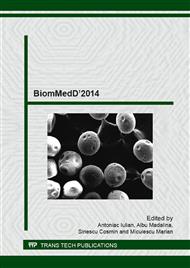[1]
Mojon P. The world without teeth demographic trends. In Feine JS, Carlsson GE, editors. Implant overdenture: the standard of care for edentulous patients. Carol Stream: Quintessence; 2003, pp.3-14.
Google Scholar
[2]
Freitas KM, Oliveira PEF, Paranhos HFO, Muglia VA, Pardini LC. Satisfaction degree evaluation of patients rehabilitated with conventional complete removal prostheses. Rev Paul Odontol 2001; 23: 25–28.
Google Scholar
[3]
McGrath C, Bedi R. Can dentures improve the quality of life of those who have experienced considerable tooth loss? J Dent 2001; 29: 243–246.
DOI: 10.1016/s0300-5712(00)00063-4
Google Scholar
[4]
MacEntee MI, Hole R, Stolar E. The significance of the mouth in old age. Soc Sci Med 1997; 45: 1449–1458.
DOI: 10.1016/s0277-9536(97)00077-4
Google Scholar
[5]
Strassburger Ckrschbaum T, Heydecke G., Influence of implant and conventional prostheses on satisfaction and quality of life: a literature review. Part2: qualitative analysis and evaluation of the studies. Int J Prosthodont 2006; 19: 339–348.
Google Scholar
[6]
Peltola MK, Raustia AM, Salonen MAM. Effect of complete denture renewal on oral health–a survey of 42 patients. J Oral Rehabil 1997; 24: 419–425.
DOI: 10.1046/j.1365-2842.1997.00510.x
Google Scholar
[7]
Davis EL, Albino JE, Tedesco LA, Portenoy BS, Ortman LF. Expectations and satisfaction of denture patients in a university clinic. J Prosthet Dent 1986; 55: 59–63.
DOI: 10.1016/0022-3913(86)90074-0
Google Scholar
[8]
Brunello DL, Mandikos MN. Comstruction faults, age, gender, and relative medical health: factors associated with complaints in complete denture patients. J Prosthet Dent 1998; 79: 545-54.
DOI: 10.1016/s0022-3913(98)70176-3
Google Scholar
[9]
Carlsson GE, Clinical morbidity and sequelae of treatment with complete dentures. J Prosthet Dent 1997: 79: 17-23.
Google Scholar
[10]
van Waas MA . Determinants of dissatisfaction with dentures: A multiple regression analysis. J Prosthet Dent 1990; 64: 569-572.
DOI: 10.1016/0022-3913(90)90130-5
Google Scholar
[11]
Batenburg RH, Meijer HJ, Raghoebar GM, Vissink A. Treatment concept for mandibular overdenture supported by endosseous implant A literature review, Int J oral Mayillofac Implants 1998; 13: 538-545.
DOI: 10.1111/j.1600-0501.2004.01085.x
Google Scholar
[12]
Weinstein AL, Klawitter JJ, Subhash CA and Schuessler R. Stress analysis of porous rooted dental implants. J Dent Res 1976; 55: 772-7.
DOI: 10.1177/00220345760550051001
Google Scholar
[13]
Murariu Magureanu C, Preoteasa E, Gavan M,. Analiza starii de efort la interfata os-implant cu metoda elementului finit (MEF). Revista Romana de Stomatologie 2008; LIV(1): 56-58.
Google Scholar
[14]
Rieger HR, Adams WK, Kinzel GL. A Finite Element survey of eleven endosseous implants. JPD 1990; 63: 457-65.
DOI: 10.1016/0022-3913(90)90238-8
Google Scholar
[15]
Tada S, Stegaroiu R, Kitamura E, Miyakawa O and Kusakari H. Influence of implant design and bone quality on stress/strain distribution in bone around implants: A three dimensional Finite Element Analysis. Int J Oral Maxillofac Implant 2003; 18: 357-68.
DOI: 10.1111/j.1365-2842.2004.01413.x
Google Scholar
[16]
Meniccuci G, Lorenzetti M, Pera P, Preti G. Mandibular implant-retained overdenture: finite element analysis of two anchorage systems. Int J Oral Maxillofac Implants. 1998; 13: 369–376.
Google Scholar
[17]
Assuncao WG, Barao VAR, Delben JA, Gomes EA, Tabata LF . A comparison of patient satisfaction between treatment with conventional complete dentures and overdentures in the elderly: a literature review. Gerodontology, 2010; 27(2): 154-162.
DOI: 10.1111/j.1741-2358.2009.00299.x
Google Scholar


